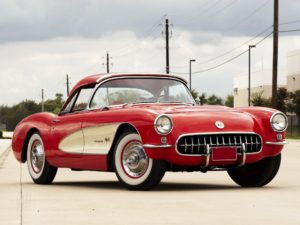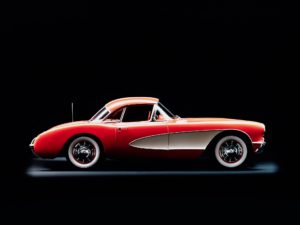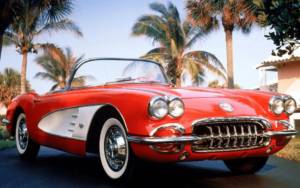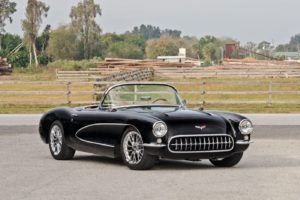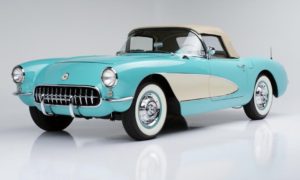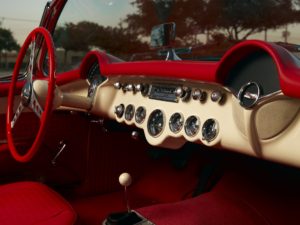In the period of just two short years, Corvette had evolved from a car that was facing the very serious threat of extinction to one that showed real promise for a long and healthy life. While General Motors still recorded only modest sales of the Chevrolet Corvette in 1956, it was apparent to everyone that it was also beginning to be taken seriously as a sports car. Even after the immense structural, physical and mechanical facelift it received in 1956, Corvette saw some major improvements in 1957
Pricing: $3,176.32
Transmission: 3 or 4 Speed Manual or Powerglide Automatic (optional)
Engine options: 283-ci V-8 (fuel injected or carbureted) – multiple horsepower options available
Top speed: 132mph
Units produced: 6,339
Available colours: Onyx Black, Polo White, Venetian Red, Arctic Blue, Aztec Copper, Cascade Green, Inca Silver
Highlights of the year:
Visually the 1957 model was unchanged. The V8 was increased to 283 cu in (4.6 L), fuel-injection became a very expensive option, and a 4-speed manual transmission became available after April 9, 1957. A new, larger 283-cid engine was placed under the hood, Mechanically, it was really still the existing 265-cid engine, though it had been bored out 1/8-inch (to 3.875 inches). This modified engine delivered an impressive 220 horsepower when coupled with a four-barrel carburetor. Dual four-barrels took it to 245 horsepower (and 270bhp.) Better still, consumers could now also purchase GM‘s newly developed “Ramjet” fuel injection system which yielded 259 horsepower (or 283 bhp). Chevy ads carried the news that the Corvette now produced “one horsepower per cubic inch”. While fuel injection is almost universal today, the very idea of it in 1957 was completely foreign to automotive manufacturers. While some European manufacturers had already begun experimenting with fuel injection in their production cars, Chevrolet turned to this new technology to bring added performance to its two-year-old V8 engine.
GM had considered using supercharging (as an alternative method to boost performance) but decided against it because of reliability issues. Fuel injection provided more precise fuel metering than a carburetor allowed, so GM assembled a development team to develop its own fuel injection delivery system. The team was comprised of Ed Cole, who had been promoted to Chevrolet’s chief in 1955; Harry Barr, who designed the 1949 Cadillac V-8 and went on to become Cole’s successor as Chevy’s Chief Engineer; John Dolza, head of fuel injection development for the GM engineering staff; and Zora Arkus-Duntov.
Interestingly, it was not engine performance but the four-speed manual gearbox that had the greatest impact on the performance aspect of the Chevrolet Corvette. Available as early as April 9, 1957, and priced at only $188.30, Regular Production Option (RPO) 685 was essentially the existing three-speed Borg-Warner transmission with the reverse gear moved into the tailshaft housing to make room for a fourth forward speed. Gear ratios were closely spaced at 2.20:1 (1st), 1.66 (2nd), 1.31 (3rd), and 1.00 (4th). Of all the Corvettes produced that year, 667 of them included this option.
“Positraction” (referred to today simply as “Posi” amongst car enthusiasts), was another separate option that was available with several different final-drive rear axle ratios which included 3.70:1, 4.11:1 and 4.56:1. Chevy’s new limited slip differential was intended to help get the most performance out of the new engines and transmissions regardless of the car’s intended purpose – be it racing or street driving.
In almost any form, the 1957 Corvette delivered uncompromising, and largely unmatched, performance. The Corvette had effectively become a street-legal sports car. As taken from an excerpt in the book CORVETTE: Sports Car Superstar: “the ’57 Corvette delivered a certifiably staggering performance
Finally, after several years of struggles ranging from meager sales to lackluster performance to poor customer acceptance, the Corvette’s future was no longer in question. The car had made incredible progress, both mechanically and socially, and the sales numbers proved it doubling from 1956 to 1957. The 1957 model year ensured the future of the Corvette and now, with the successes the car was showing on a regular, repeating basis, Chevrolet added it indefinitely to its production car line. Still, with a car that still had room to grow, the Corvette development team had to find ways to improve on a machine that had become, for many, the ideal American Sports Car.
Photos of the 1957 Corvette:
Sources:
https://www.corvsport.com/1957-c1-corvette/
https://en.wikipedia.org/wiki/Chevrolet_Corvette_(C1)
https://www.corvsport.com/1957-c1-corvette-image-gallery
